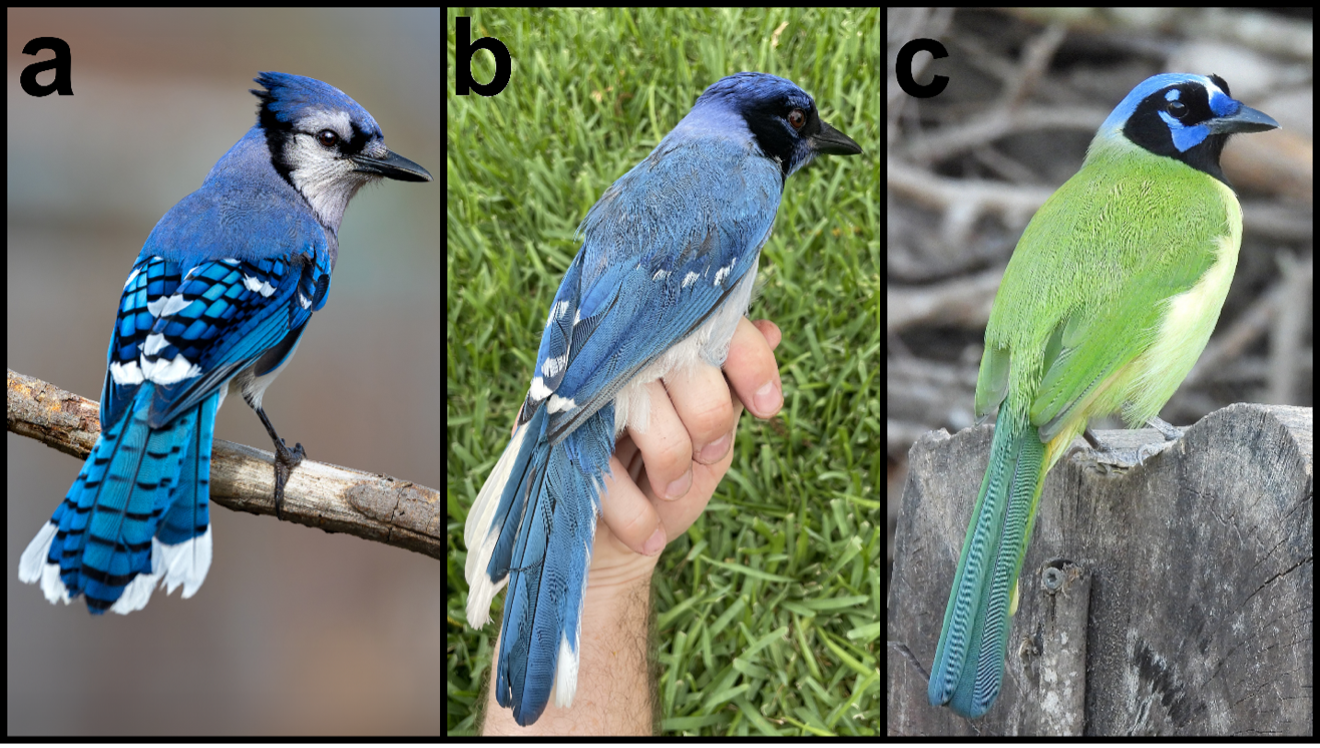Green Jay x Blue Jay Paper
Posted September 10, 2025
In June of 2023, we were stunned to discover a putative hybrid jay in a suburb outside of San Antonio, Texas with the help of landowner and original observer Donna Currey. PI Keitt and doctoral candidate Brian Stokes were able to observe the bird in the field, band it, and collect a small blood sample for genomic analysis. You can read the paper here
 a. Blue Jay by Travis Maher. Cornell Lab of Ornithology - Macaulay Library. b. Hybrid Jay by Brian R. Stokes. c. Green Jay by Dan O’Brien. Cornell Lab of Ornithology - Macaulay Library.
a. Blue Jay by Travis Maher. Cornell Lab of Ornithology - Macaulay Library. b. Hybrid Jay by Brian R. Stokes. c. Green Jay by Dan O’Brien. Cornell Lab of Ornithology - Macaulay Library.
The putative hybrid’s paternity was uncovered using whole-genome sequencing and comparative bioinformatic techniques to confirm this bird to be a F1 hybrid resultant of the mating between a female Green Jay (Cyanocorax yncas) and a male Blue Jay (Cyanocitta cristata). This finding offers rare insight into how climate change and human-altered landscapes are bringing previously isolated species into contact. Green Jays are typically found from South Texas through Central and South America, while Blue Jays dominate eastern and northern forests. Their overlap in South Texas is narrow, and until now no wild hybrids had ever been documented. As warming temperatures and shifting habitats continue, such cross-species encounters may become increasingly common.
While hybridization is commonly observed between bird species, we see this observation as particularly interesting because:
- the parent species are in different genera with the last common ancestor around 7 million years ago,
- these are intelligent, social species and, as such, have more complicated behavioral barriers to mating, which is quite different we assert than, for example, hybridization in bears,
- the original interest in the Green Jay is their rapid, somewhat unprecedented, range expansion from southern to central Texas, so this event represents anthropogenically driven “global weirding” where communities and ecosystems are being reshuffled, and
- many climate-biodiversity impacts have been documented at northern latitudes, whereas our observation highlights the dynamism of sub-tropical environments that are experiencing rapid tropicalization.
Press coverage:
- So What Should We Call This – a Grue Jay?
- First known wild ‘grue jay’ hybrid spotted in Texas
- This unusual hybrid found in Texas is the first of its kind in the wild
- Climate change might be pushing different species together, researchers say upon ‘grue’ jay discovery
- This ‘Grue Jay’ Hybrid Looks Cool as Hell—but It’s a Warning Sign
- ‘Grue jay?’ Homeowner spots first blue jay and green jay hybrid in Texas. See it
- What’s a ‘Grue Jay’? Introducing the new hybrid love child of the Blue and Green Jays
- Encontraron en la naturaleza el primer animal híbrido
- Strange Bird Spotted in a Texas Backyard Is the First Known Hybrid Between a Blue Jay and a Green Jay
- Rare blue-and-green hybrid jay spotted in Texas is offspring of birds whose lineages split 7 million years ago
- Biologists In Texas Just Identified The ‘Grue Jay,’ The First Known Hybrid Of A Blue Jay And A Green Jay
- ‘Grue jay?’ Homeowner spots first blue jay and green jay hybrid in Texas. See it
- Meet Grue Jay: Rare hybrid offspring of a blue jay and a green jay born of climate change
- Meet the ‘grue jay,’ a rare hybrid songbird
- No two jays about it: Researchers discover new ‘Grue Jay’ in South Texas
- A blue jay and a green jay mated, researchers say. Their offspring is a scientific marvel